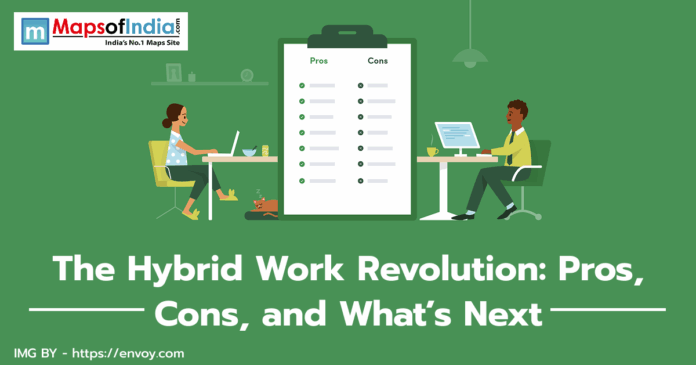The hybrid work model is developed with a blend of office and remote setups. This revolution emerged during the COVID-19 pandemic. By the end of this year, 70% of U.S. companies are expected to adopt this model. According to the recent McKinsey Global Institute report, a 20% increase in productivity is predicted. Employees will be able to split time between home and office. This flexibility reshapes the view toward the work-life balance. It offers autonomy but challenges collaboration. Companies like Google and Microsoft are adapting this way. According to the recent Gallup survey, 53% of workers prefer a hybrid work arrangement. This revolution is transforming workplaces. It balances life and efficiency.
Rise of Hybrid Work Post-Pandemic
The hybrid work model exploded in 2020. Lockdowns forced big companies to look for remote setups. According to the Owl Labs report, during the time of the pandemic, 80% of firms went hybrid. It combines in-person and virtual. Before the pandemic, 20% of U.S. workers were working remotely. Now this percentage has reached 58%. A recent U.S. Bureau of Labour Statistics data confirms this. Companies are using tools like Zoom. According to the Microsoft Work Trend Index, 73% of employees want flexible working hours. Working in a hybrid setup reduces the time needed for commuting by 1 hour daily. According to the Global Workplace Analytics study, this way companies can save $11000 in savings per employee yearly. It lowers office space needs by 30%. The model evolved from necessity to preference. It redefines productivity.
Pros: Flexibility and Work-Life Balance
Working in the Hybrid model offers freedom. Employees choose where they want to work from. People want to have a better work-life balance. Working in the hybrid model cuts the stress needed for commuting. Workers save 60 hours monthly, which were needed to travel from home to offices. Workers now work in a good and familiar environment, increasing their productivity. According to the Owl Labs report, the productivity of employees rises 20% while working in the preferred settings. It will result in achieving a higher output. It attracts talent. 83% of millennials prefer a hybrid work model while looking for jobs. There is no need for companies to build that way; companies can save on real estate. The rise of the hybrid work model has reduced office use by 50%. A recent Global Workplace Analytics study says $1.4 trillion in potential savings globally with the adoption of a hybrid model. It also supports inclusivity. Parents and disabled workers can also work without any problem. Hybrid empowers diverse teams.
Pros: Cost Savings and Environmental Benefits
Hybrid cuts costs for the amenities needed for employees in the office space. Employees save $6000 yearly needed for travelling from home to office. Employees were able to save money on gas and lunch. Companies reduce office space by 30%. A McKinsey Global Institute study predicts $800 billion in real estate savings. It lowers carbon emissions, keeping most people at home and reducing the pollution caused by vehicles. Remote work cuts 54 million tons of greenhouse gases yearly. Less traffic eases urban congestion. The hybrid work model supports green practices. According to the Deloitte survey, 68% of firms adopt sustainable policies. It saves energy in offices. Hybrid’s economic and eco benefits are clear.
Cons: Collaboration and Communication Challenges
The rise of a hybrid work culture has hindered teamwork. Virtual meetings became the only thing for the connect. The interaction with each other daily vanished. This does not build a team working model, and when the time comes to work in the group, it becomes difficult for workers to function properly in the group. Miss non-verbal cues. A recent Microsoft Work Trend Index says that 58% of workers feel disconnected. Miscommunications among coworkers have risen by 25%. A recent study by Harvard Business Review notes this. Employees working in the office bond more easily with each other. Remote teams face isolation. A recent survey by Gallup says 30% of employees working in a hybrid environment report loneliness. Informal chats vanish from their routine. If the work setup is fully hybrid, Innovation drops 15%. Time zone differences delay the decision-making process. Global teams struggle to complete their work due to the availability of employees on time. A hybrid work model requires better tools to manage everything. It challenges company culture.
Cons: Productivity and Work-Life Boundaries Blur
Hybrid blurs the line between home and workplace. While working from home, employees work longer hours than they would have worked in the office. According to the report by Owl Labs, due to a hybrid culture, a 20% increase is seen in overtime. Distractions like family or other stuff reduce focus on the work. A McKinsey study says 40% face home interruptions. Burnout rises 35%. Managers struggle to monitor the performance of the employees. Trust issues emerge from both sides due to less interaction on a daily basis. A recent Harvard Business Review article says 50% of leaders worry about visibility. Remote workers miss the chance of getting a promotion. Working in a hybrid environment demands self-discipline. It tests work-life balance.
What’s Next: AI and Tech Integration
The emergence of AI is reshaping the hybrid work culture. Tools like Microsoft Copilot summarise meetings; due to that, employees pay less attention to the meetings in real time and sometimes miss crucial things. On the other hand, it might be helpful for some employees. A recent Microsoft report says it saves 11 hours weekly for workers. VR offices enable virtual collaboration. A recent Deloitte survey says 30% of firms test the metaverse. According to the Owl Labs report, this model might be adopted by 50% of companies by 2030. Blockchain secures remote data. It reduces breaches by 40%. Wearables track wellness to prevent burnout among employees. Tech bridges hybrid gaps. It enhances productivity and connection among employees.
Conclusion
The hybrid work culture revolution is here, and it’s rapidly being accepted in different aspects of the workforce. This environment offers flexibility in working hours and saves a lot of time. According to the recent McKinsey report, this work culture will be adopted by 70% of firms in the coming years. Pros include better balance and lower costs. Cons like isolation among employees are still there. According to the Gallup survey, 53% employees prefer working in a hybrid environment. AI and VR will shape its future. Policies like four-day workweeks are being accepted by many big firms. The rise of the hybrid work culture has transformed the way workplaces function. Some people are doing two jobs at a time. It balances life and efficiency.





